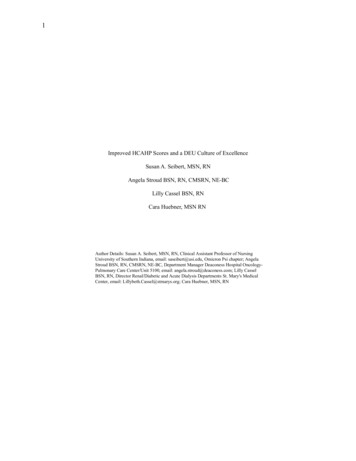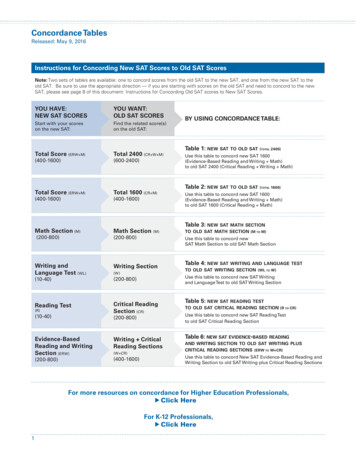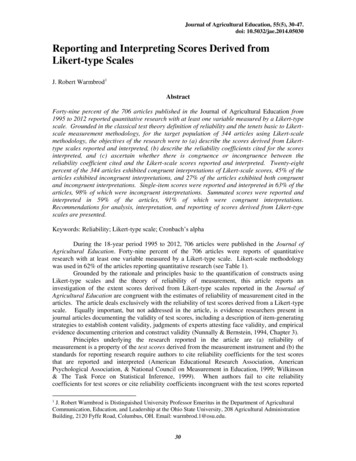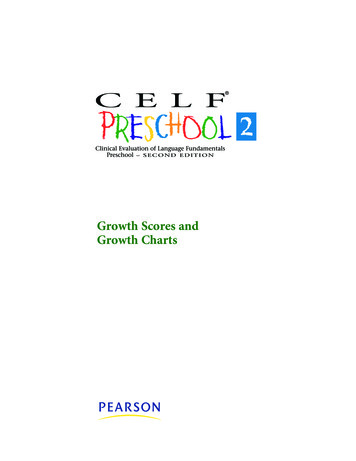
Transcription
1Improved HCAHP Scores and a DEU Culture of ExcellenceSusan A. Seibert, MSN, RNAngela Stroud BSN, RN, CMSRN, NE-BCLilly Cassel BSN, RNCara Huebner, MSN RNAuthor Details: Susan A. Seibert, MSN, RN, Clinical Assistant Professor of NursingUniversity of Southern Indiana, email: saseibert@usi.edu, Omicron Psi chapter; AngelaStroud BSN, RN, CMSRN, NE-BC, Department Manager Deaconess Hospital OncologyPulmonary Care Center/Unit 5100, email: angela.stroud@deaconess.com; Lilly CasselBSN, RN, Director Renal/Diabetic and Acute Dialysis Departments St. Mary's MedicalCenter, email: Lillybeth.Cassel@stmarys.org; Cara Huebner, MSN, RN
2AbstractTwo city hospitals launched Dedicated Education Units (DEUs) in collaboration with a Midwest state university.The culture of excellence created by the academic practice partnership produced an improvement in patientsatisfaction scores at both hospitals. Hospital Consumer Assessment of Healthcare Providers and Systems(HCAHPS) survey scores improved dramatically within one month of DEU launch. This manuscript presents thepre- and post- DEU HCAHPS scores and relates surprising trending with student presence on the units.
3Improved HCAHP Scores and a DEU Culture of ExcellenceThe nursing literature reports multiple avenues of tracking Dedicated Education Unit (DEU) outcomes. However,there are few reports that address quantitative outcomes. Two city hospitals launched DEUs in collaboration with aMidwest state university. A comprehensive tracking agenda for all stakeholders’ outcomes was agreed upon withinthe academic practice partnership. One of the surprise early outcomes was an increase in patient satisfaction scoreswithin one month of DEU launch at both medical facilities. This manuscript will describe increases in patientsatisfaction as a reflection of the culture of excellence created within the DEU academic practice partnership.Dedicated Education UnitsDEUs represent an innovative academic practice partnership designed to optimize clinical placement opportunitiesfor student nurses by utilizing the expertise of staff nurses.1 The DEU model of clinical education allows greaterclinical placement opportunities by virtue of being promised to, or dedicated to, only one school of nursing.Typically the units are not shared with other schools of nursing, promoting a greater depth of understanding by thenursing staff of the nursing school’s progression of courses, clinical expectations, and student abilities. The membersof the academic practice partnership collaborate together to create an optimal learning environment which issatisfactory for both the practice environment and the school of nursing. Nursing literature documents multipleoutcomes from the DEU clinical model including the ability to increase nursing school enrollment, an increase instudent confidence with patient care skills, and an increase in student attainment of quality and safetycompetencies.2,3,4Most nursing studies report qualitative outcomes of DEUs. Only one article reports a DEU’s influence on patientsatisfaction scores. Castner, Ceravolo, Tomasov, & Mariano5 compared scores of units with traditional clinicalgroups with the scores of units that have adopted the DEU clinical model. The article reports no statisticaldifference between the two different models of clinical education with respect to influencing patient satisfactionscores. However, the authors noted trends that may indicate that the DEU model could have impact on patientsatisfaction scores.
4Visioning OutcomesWhile in the planning phases to implement the DEUs, both sites enlisted staff members to draft vision or missionstatements. As evident in the statements cited below, quality patient outcomes were a goal from the very beginning.Vision statement site A: Our vision is to improve patient outcomes, nurse recruitment and nurse retentionby fostering a positive environment for student learning and professional development throughcollaboration between nurse leaders, staff, students and faculty.Mission statement site B: Our Mission is to create a learning environment that facilitates holistic carethrough compassion and knowledge; to go above and beyond to exceed expectations and achieve theHighest Quality Patient Outcomes. TOGETHER, we strive to strengthen our evidence based practicethrough continuous research and innovation dedicated to life-long learning. By forming a habit ofExcellence, we create professionals who will lead and shape the future of nursingThe practice partners planned to collect data on multiple quality indicators to support the cost-benefit analysis forlaunching the DEUs, as well as, the direct and indirect costs of maintaining DEUs. Patient satisfaction was amongthe quality items slated to be analyzed. Both hospitals use the Hospital Consumer Assessment of HealthcareProviders and Systems (HCAHPS) survey to track this outcome.A Healthcare Community of Practice theoretical model was adopted by the academic practice partnership to frameinteractions, knowledge management, and outcomes. Within a Healthcare Community of Practice, memberscollaborate to enhance practice in the healthcare environment, promote professional expertise, and work together togenerate new knowledge such as projects that benefit all members and stakeholders.6 Improved patient satisfactionresults from provider collaboration and provider expertise could be a result of process improvement projects. Thetheoretical model, a Healthcare Community of Practice, provided the framework to operationalize the academicpractice partnership and frame outcomes of the DEU such as, patient satisfaction scores.
5HCAHPS ScoresThe Hospital Consumer Assessment of Healthcare Providers and Systems (HCAHPS) survey was developed by theCenters for Medicare & Medicaid Services (CMS) in partnership with the Agency for Healthcare Research andQuality (AHRQ). Implemented in 2006 as a survey instrument and data collection methodology to measure patients’perceptions of their hospital experience, the HCAHPS instrument is the first nationally standardized, publiclyreported, survey of patients’ perspective of hospital care. While many hospitals utilized patient satisfaction surveysfor their own internal use, there was no national standard for collecting and publicly reporting of this information.The HCAHPS survey allowed for hospitals to make valid comparisons about the patient experience of care locally,regionally, and nationally.7There are three broad goals of HCAHPS. The first goal is to produce data about the patients’ perspectives of carethat allows objective and meaningful comparisons of hospitals. Second, public reporting of this information createsincentives for hospitals to improve quality of care. Third, the public reporting has led to total transparency of thequality of hospital care provided.7 The survey is administered to discharged patients that meet certain criteria andasks 32 questions about their recent hospital stay. These questions are then lumped into eight domains: GlobalDomain (Overall Rating), Communication with Nurses, Responsiveness of Hospital Staff, Communication withDoctors, Pain Management, Communication about Medications, Overall Hospital Environment, and DischargeInformation. The questions are scored based on the patients’ perception of care as never, sometimes, usually, andalways. The percent “always” is what organizations measure and report .7The HCAHPS survey results form the basis for the Patient Experience of Care domain in the Hospital Value-BasedPurchasing program. Hospitals must publicly report HCAHPS data to receive their full inpatient prospectivepayment (IPPS) annual payment update (APU). Hospitals that fail to report the required quality measures mayreceive a reduction in APU payments .7Early ResultsWithin one month of DEU launch, both unit managers reported dramatic increases in HCAHPS scores. Site Adocumented an increase from meeting only two of the benchmarks one month pre-DEU launch to meeting all the
6benchmarks one month post DEU launch. Site B did not meet any benchmarks one month pre-DEU, but within onemonth post DEU launch met the benchmarks in all eight domains. Table 1 contains the results from both units’ onemonth pre-and post DEU launch. Three month cumulative tracking resulted in Site A improving HCAHPS from abaseline of meeting the benchmark in only two of the eight domains to meeting the benchmark in two domains andexceeding the benchmark in five domains with significant improvement in the remaining domain. The Appendixcontains line graphs depicting each unit’s improvement with HCAHPS scores. Overall, Site A had a 16.1%improvement in HCAHPS scores and Site B had a similar, 16.8%, improvement.Table 1HCAHPS scores one month pre and post DEU launchHCAHPs CategorySite A1 month PreDEUSite A1 month PostDEUSite B1 month PreDEUSite B1 month PostDEUOverall Rating of Hospital62.575.052.080.0%Communication with Nurses76.588.470.790.3%Responsiveness of Staff51.165.259.672.3%Communication with Doctors58.791.781.391.4%Hospital Environment Clean/Quiet73.575.056.071.4%Management of Pain79.280.066.776.1%Communication Regarding Medications33.375.046.263.9%Received Discharge Information79.091.665.987.1%Benchmarks are specific to each facility. Gray shading signifies not meeting the benchmark. White signifiesmeeting the benchmarkNo statistical inferences could be drawn regarding the relationship of students present on the units and theimprovement of patient satisfaction scores because of insufficient monthly samples of scores. However, trending ofmonthly scores when overlaid with student presence on the units revealed indications of early correlations. Table 2reflects trends of improvements with the DEU model. Scores remained elevated during the spring 2013 pilotsemester with nursing students in the second medical/ surgical rotation through another pilot during May and Junewith senior-level nursing students in their fourth medical/surgical rotation. There were no students on either of theDEUs for the months of July and August. HCAHPs scores for those months reflected a drop to meeting five or lessof the benchmarks. For Site B, July’s scores registered only meeting two of the eight benchmarks. In the Fall,
7students in the first medical /surgical course were placed on both DEUs in the traditional clinical model. Scoresimproved slightly. As the students in the first medical/ surgical rotation gained competence and confidence inpatient care, they were paired with staff RNs as described in the DEU model. At this time, the scores for Site Bimproved again. Table 2 includes Site B’s monthly scores correlated with student presence on the unit. Site Aproduced similar outcomes until mid-September when the institution implemented a new electronic medical healthrecord system confounding the tracking of student impact.Table 2 Site B One Year Treanding ResultsGray signifies not meeting the benchmark. White signifies meeting the benchmark. Star indicates DEU launch.First black arrow indicates no students on the unit. Second black arrow indicates a traditional model of studentplacements. The first white arrow indicates a mix of traditional and DEU placements. The second white arrowindicates placements using only the DEU model.Influencing FactorsThe academic practice partnership suggests that the early dramatic improvement in patient satisfaction scores isrelated to the culture of excellence created within the Healthcare Community of Practice framework. Severalinfluencing factors have been proposed as the source for this culture of excellence. The first factor takes intoaccount the staff’s desire to be professional role models for the nursing students. The staff recognizes theimportance of portraying standards of care and professional deportment in the shaping of nursing student’s image ofnursing as well as in the development of nursing student’s values toward quality care. The consistent placement of
8students placed on the DEUs for full twelve hour shifts, on all three shifts including weekends, encouraged all theDEU staff to become role models.The second influencing factor is the school of nursing’s mandate for teaching best practice protocols and principles.Not only do the students learn the most current evidence-based practice in the classroom but also best teachingprinciples are embedded in clinical education. The staff nurses on the DEUs are educated about student clinicalobjectives and instructed in the art of clinical instruction within an eight hour workshop that is hosted by school ofnursing faculty. During the workshop, staff nurses are taught the expectations for students in upholding bestpractice interventions and quality of care considerations. For example, students are expected to explain to thepatient each medication as they are opening the packet and placing the medication in the pill cup. The students mustinclude significant side effects and use teach- back methodology to determine patient comprehension. Anecdotally,unit managers and school of nursing faculty have observed that not only the nurses who are assigned students but allnurses have adopted this method of explaining medications to patients. This quality measure is realized in theHCAHPS domain of “communication about medications”. Site A improved within this domain from 33.3% ofpatients reporting that they agreed that the nurse always communicated about medications pre-DEU to 75% onemonth post DEU. Site B recorded similar improvement in this domain with 46.2% of patients claiming that the nursealways communicated about medications pre-DEU to 63.9% post DEU.The third influencing factor reflects the nature of the student experience on the DEUs. Within the HealthcareCommunity of Practice, the DEU staff embraces the students as active members of the team rather than guests orobservers on the unit. Student input is sought regarding patient plans of care as well as unit evidence-based projectsand quality improvement initiatives. Including the students as part of the care team enhances communication withinthe nurse-student dyads, within interprofessional teams, and across care transitions. There is evidence of reciprocallearning as students offer their expertise of how to conduct evidence-based literature reviews that enhance unitquality and safety initiatives.
9SummaryThrough the academic-practice partnership, a culture of excellence has been created where students have theopportunity to impact practice and patient satisfaction. Results of the HCAHPs surveys demonstrate a fulfillmentof the DEU theoretical model, a Healthcare Community of Practice, and both hospital units’ mission statements.References1. Murray T, Crain C, Meyer G, McDonough M, Schweiss D. Building bridges: an innovative academicservice partnership. Nursing Outlook [serial online]. September 2010;58(5):252-26.2. McKown T, McKown L, Webb S. Using quality and safety education for nurses to guide clinical teachingon a new dedicated education unit. The Journal of Nursing Education [serial online]. December2011;50(12):706-710.3. Moscato S, Miller J, Logsdon K, Weinberg S, Chorpenning L. Dedicated Education Unit: an innovativeclinical partner education model. Nursing Outlook [serial online]. January 2007;55(1):31-37.4. Ranse K, Grealish L. Nursing students' perceptions of learning in the clinical setting of the DedicatedEducation Unit. Journal of Advanced Nursing [serial online]. April 2007;58(2):171-179.5. Castner J, Ceravolo D, Tomasov B, Mariano K. Dedicated educational units: what's the impact on patientsatisfaction?. Nursing Management [serial online]. April 2012;43(4):14-18.6. Seibert, S. The meaning of a Healthcare Community of Practice. Nursing Forum. 2015; 50(2): 69-74.doi:http://dx.doi.org/10.1111/nuf.120657. Hospital Consumer Assessment of Healthcare Providers and Systems. CAHPS Hospital Survey. Retrieved2014. from http://www.hcahpsonline.org/home.aspx
10AppendixLine graph Site A St. Mary’s DEU pre and post launch HCAHPs scoresLine graph Site B Deaconess DEU pre and post launch HCAHPs scores
11
Angela Stroud BSN, RN, CMSRN, NE-BC Lilly Cassel BSN, RN Cara Huebner, MSN RN Author Details: Susan A. Seibert, MSN, RN, Clinical Assistant Professor of Nursing . receive a reduction in APU payments .7 Early Results Within one month of DEU launch, both unit managers reported dramatic increases in HCAHPS scores. .










